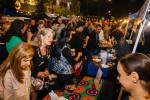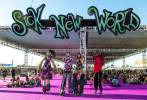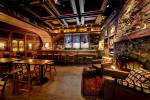At 40, Las Vegas Greek festival keeps getting bigger
The first Las Vegas Greek Food Festival was held in 1973 at the Stardust and attracted about 5,000 people during its one-day run. The 40th, scheduled for Friday through Sunday on the grounds of St. John the Baptist Greek Orthodox Church near Jones Boulevard and Hacienda Drive, is expected to draw about 26,000.
And if the festival has grown exponentially in the intervening years, so has the church, in a quintessential symbiotic relationship.
"Back then we had probably 150 families on the rolls," said Gus Flangas, festival chairman. "We have about 600 now."
Flangas remembers, as a very young child, the Greek Orthodox community of Las Vegas meeting for a short time in an Episcopalian church on Maryland Parkway. They opened their own church, on about an acre of land, at Carson Street and Bridger Avenue in 1961.
"The old church hall was built on the labors of the members," Flangas said. "A lot of folks had skills. They had work parties on Saturdays. They came out and laid the foundation, laid the brick, did the wiring and built a really nice community center."
The members used to have a party about once a month, Flangas said, that would go until about 2 in the morning.
"People would dance all evening and have a great time," he said. "That was really something that was manifested in those early days at that church."
And so was a pattern of working together.
"The church that we're in now is a dream since the late '60s, early '70s," Flangas said. "Growing up in the church, it was really neat to see that come to fruition in the way it did. That's a culmination of a dream that's been held for a lot of years."
The fruit of their labor is a 10-acre property in the southwest valley, on which ground was broken in 1990. The stately church was completed in 1992, Flangas said, and the festival moved to the church grounds in 1994.
"All we had was the foundation for the community center," he said. "We had rebar sticking up and covered it all with plywood."
They cooked on outdoor grills and rotisseries and had access to an oven about five miles away.
"We had kids with pickup trucks who were running the food back and forth," Flangas remembered with a laugh. "It was quite a production. It was two days, and it actually rained on us a little, but that didn't dampen the spirit at all."
By 2003, the bare foundation had become a polished 26,000-square-foot community hall, complete with commercial-quality kitchen that would be the envy of most professional chefs. The kitchen is for the festival, which is for the church. And so was that 10 acres.
"The festival was always in there, because the festival was our biggest event," Flangas said. "It's the biggest showcase of our culture and our church."
One thing that hasn't changed is the food, although Flangas said offerings have expanded quite a bit over the years. Back then, he said, the focus was more toward chicken. Today he said, leg of lamb is one of the mainstays.
"Every year, we're doing something to make it better," Flangas said of the festival. That usually means introducing new food items, and this year lamb chops and cooked lamb sold by the pound will be served.
That's in addition to the chicken, pastitisio, gyros, souvlaki, calamari, Greek salad, Greek fries, saganaki, Greek sausage, pastries and on and on.
Volunteers are, of course, what make the festival a success, and more than 300 generally are involved these days. Food preparation started weeks ago, keeping the volunteers busy in that big kitchen.
"Already," Flangas said a couple of weeks ago, "we've cooked up 15,000 stuffed grape leaves."
Contact reporter Heidi Knapp Rinella at hrinella@reviewjournal.com or 702-383-0474.
PREVIEW
What: 40th annual Greek Food Festival
When: 3 to 11 p.m. Friday and Saturday, noon to 10 p.m. Sunday
Where: St. John the Baptist Greek Orthodox Church, 5300 S. El Camino Road
Admission: $7 for adults, free for children 12 and younger and active-duty military and members of their families





























